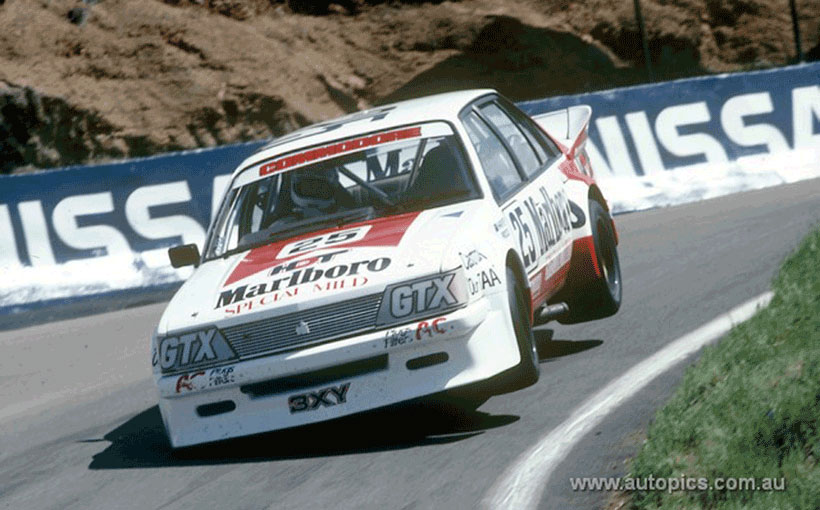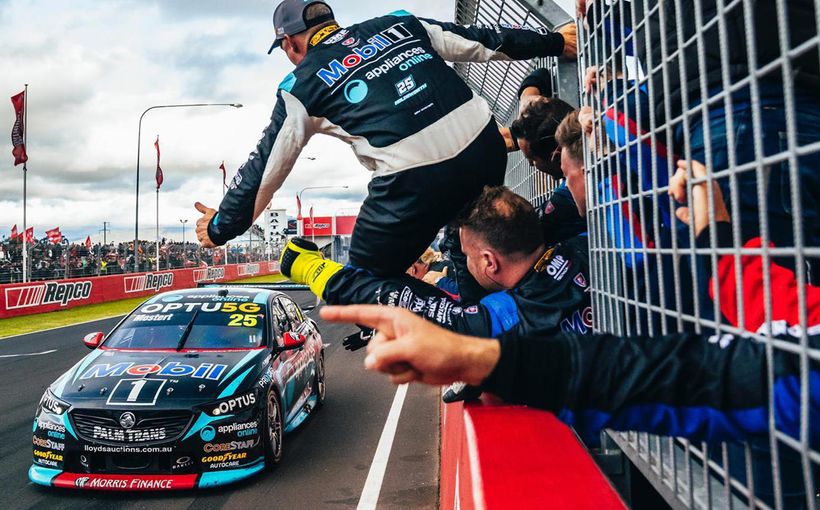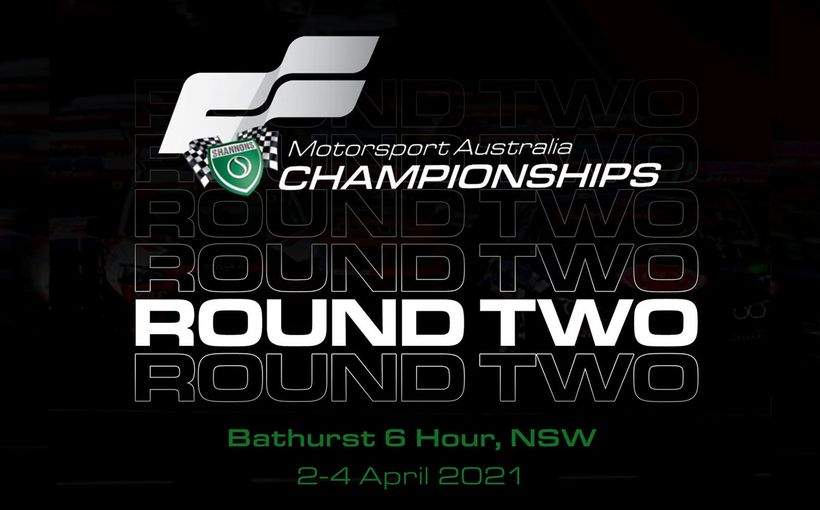VH Commodore SS: The Cop Car that won Bathurst

“It’s a police car without a siren!” was how Peter Brock described his new VH Commodore SS race car to the press when it was under construction in June 1982. What may have seemed a flippant one-liner in Auto Action was in fact a succinct and accurate summation of how a no-frills road car had served as the starting point for an HDT race car that would win two Bathurst 1000s.
Released in September 1982, the VH SS combined the two best elements of Holden’s V8 police pursuit special – high power with low weight. The Confederation of Australian Motor Sport (CAMS) approved it as the production car basis for Holden’s new race car.
This was a crucial breakthrough for Brock, after enduring a long and bitter battle with CAMS from 1980 to 1982 in seeking approval to race with the big-valve L34-type heads fitted to his road going HDT Commodores.
The creation of the VH SS road car by GM-H, primarily to serve as the springboard for HDT’s competition cars and high performance road cars, shows how strong the ties were between The General and HDT in those days.
Consecutive Bathurst 1000 victories in 1982 and 1983 owed as much to HDT’s superior race craft as they did to the VH SS road car on which the winning car was based – and which HDT helped to develop.

1980-1982: Big valves mean big trouble
1980
The catalyst for development of the VH SS Group C touring car can be traced back to the Commodore’s debut in the ‘new look’ Australian Touring Car Championship in 1980.
This season saw not only the introduction of the latest European-inspired sedans from Holden (VB Commodore) and Ford (XD Falcon), but also a switch to what CAMS referred to as ‘anti-pollution’ engines to present a more environmentally responsible image for the sport as it entered a new decade.
In reality, ‘anti-pollution’ simply meant that XD Falcon runners had to replace the high performance closed-chamber 4V cylinder heads and inlet manifold on the 351 cid (5.8 litre) Cleveland V8 with the lower compression, open-chamber 2V versions.
And Commodore teams had to replace the big-valve Torana L34-type heads and inlet manifold on the 308 cid (5.0 litre) V8 with the more restrictive small-valve heads and manifold used on the company’s standard L31 road car variant.
Both cars were short of breath, but it was more noticeable in the Holden V8 due to its smaller capacity. What had been close to 400 bhp in the Torana A9X the previous year had been slashed to just over 300 bhp in the Commodore. Although Brock dominated the 1980 ATCC, his third title was secured against thin competition.
Not that Brock was concerned about his future power requirements. It was planned that these shortcomings would be cured before the Bathurst 1000 that year, by homologating the big-valve heads and inlet manifold as fitted to his new HDT VC Commodore ‘special vehicle’ road cars.

However, CAMS refused to approve them on the grounds that not enough of the HDT road cars (minimum 500) had been produced in time for the endurance races, so Brock was stuck with the small-valve heads.
CAMS’ refusal to grant Brock’s wish showed that other forces were at play. Granting of homologation approvals before the required number of vehicles had been built was an accepted practice, built on trust between CAMS and manufacturers that the production numbers would eventually be met.
However, having seen the dominant performance of Brock’s small-valve VB Commodore in the ATCC, CAMS was concerned that a more powerful VC version was going to wipe out what little competition there was for HDT. The governing body dug its heels in.
Brock’s victories in the Adelaide 250, Sandown 500 and Bathurst 1000 endurance races later that year with the small-valve heads certainly appeared to vindicate CAMS stance on the issue!

1981
The dispute between HDT and CAMS dragged on throughout 1981, with Brock continuing to lobby for the big-valve heads in the face of stiff competition from Dick Johnson’s more powerful 5.8 litre XD Falcon, which won both the ATCC and Bathurst 1000 that year.
CAMS still refused to budge until it was satisfied that the required number of HDT road cars had been produced. In fact, official recognition of the VC ‘Brock’ Commodore was not granted until three months after production of that model had ceased, which left Brock disillusioned with his treatment.
“For the umpteenth time, I’ll remind everyone that no manufacturer has ever had to do that before,” he told Australian Motor Racing.

1982
Brock and his fellow VC Commodore racers were finally granted approval to run the big-valve heads from the start of the 1982 season. However, their collective sigh of relief was only brief as another ugly legal battle erupted that ended up in the Supreme Court.
What triggered the stoush was a new set of minimum vehicle weights introduced by CAMS to ensure that any engine used in a touring car was installed in the same body as the road car version. For HDT this meant carrying a lot more weight (from about 1250 kgs to a new 1327 kgs minimum), as its VC road car was based on Holden’s heaviest top-shelf SL/E model loaded with luxury equipment.
A breakdown in communication between CAMS and Holden teams over how these new weight rules would be applied, though, led to farcical scenes in the second round of the 1982 ATCC at Melbourne’s Calder Park.
HDT and other Commodore teams running the new big-valve ‘HDT Special’ arrived at Calder for the start of practice with lead ballast placed in their cars to meet the new minimum weight, rather than the “luxury equipment” as specified by CAMS.
After lengthy arguments between the practice sessions, it was decided that competitors could temporarily secure the various luxury items in the cars (as close as possible to their road car locations) for the Calder round before being properly installed before the next round in Tasmania.
Holden rivals at Calder must have got a good laugh from seeing Brock and other Commodore drivers lining up on the grid with various luxury road car items strapped and taped inside their engine bays and passenger compartments! (see photo)

Brock duly won the 50-lap race but his joy was again to be short-lived when scrutineers ruled that the inlet manifold on his winning HDT car and a couple of private entries had received a metal finishing treatment that did not comply with the rules.
Brock lost his points from the meeting and was handed an immediate three-month suspension. The Bathurst champ was so incensed by what he saw as a gross injustice that he boldly launched legal action against CAMS in the Victorian Supreme Court.
With Brock racing under appeal from then on, interest in the 1982 ATCC quickly fell away as no one knew if the championship-winning points he accumulated were going to stick due to the ongoing dispute with CAMS. The conflict was finally settled out of court, with Brock forfeiting his claim to the 1982 ATCC.
The ill-feeling created by the whole painful saga over the big-valve cylinder heads was also something that Brock/HDT and General Motors-Holden wanted to avoid in future. They had to find a better way of doing things - so they dialled 000.

1982: Holden chases the chasers
GM-H didn’t start pursuing police vehicle fleet business with the Commodore until after the new VH series was launched in September 1981.
The imminent demise of the big 351 cid (5.8 litre) V8 Ford Falcons in 1982, which were favoured by Highway Patrol officers across the country, presented a golden opportunity for Holden to fill the void with it latest VH series.
These bare-boned, vinyl-trimmed, SL models were available with 3.3 litre six or 4.2 litre and 5.0 litre V8s, with either Trimatic auto or M21 four-speed manual transmissions. Holden also developed a special police suspension (FE2) and a National Police Package (BT1) which comprised various comfort and performance items tailored to rugged police duties.
The ‘big grunter’ aimed at high speed pursuit work was the 177kW version of the 5.0 litre V8 (PO V5H) complete with Brock/Perfectune-supplied big-valve cylinder heads, inlet manifold and cold air feed. This engine was so good it would later be specified for all manual Commodores ordered with the 5.0 litre V8 option.
These police pursuit VH Commodores with the Brock-spec V5H engine and manual gearbox were seriously quick and stealthy muscle cars. Not surprisingly, it was this combination of low weight and high horsepower that presented itself as the obvious platform for development of Holden’s next Bathurst winner.

VH SS: The perfect solution
The VH Commodore SS road car launched in September 1982 was an attractive re-packaging of the no-frills base model SL sedan, that established the SS as an on-going factory ‘stripper’ performance model that would underpin the homologation of future Group C and Group A Commodore race cars.
It would also serve as the starting point for HDT’s Group One, Group Two and Group Three high performance road car offerings.
Available in Maranello Red and later Alabaster/Alpine White, the VH SS featured Cheviot 14 x 6-inch alloy wheels, body colour highlights and black paint accents in an attractive and budget-priced performance package.
Carrying the factory code 8VK69-XV2, the new SS Pack SL sedan came standard with the 4.2 litre V8, M21 four-speed manual gearbox, 3.08:1 diff and four-wheel disc brakes. The 5.0 litre V8 was optional.
Therefore, by presenting CAMS with paperwork that combined the VH SS’s low weight with the big-valve 5.0 litre V8 available in both Holden’s police pursuit car and HDT’s Group Three, Brock’s two long standing homologation problems with his race cars were finally solved.
And with the usual smoke-and-mirrors of the Group C era, CAMS rubber-stamped the new SS just in time for Bathurst, even though Brock’s rivals raised considerable doubts about the car’s eligibility (in terms of production numbers) given its release so close to Australia’s biggest race.

1982 Bathurst 1000
The newly homologated VH SS Group C touring car debuted at the 1982 Sandown 400, regarded as the traditional curtain raiser to the Bathurst 1000 each year and useful form guide for ‘the big one’.
With a low racing weight of around 1260 kgs (dry), the new SS’s big-valve 5.0 litre V8 in full Group C race trim was good for about 390 bhp, resulting in a formidable power-to-weight ratio that would prove very difficult for its Ford, Chevrolet, Mazda, Nissan, BMW and Jaguar opposition to counter.
A Borg & Beck triple-plate clutch, homologated Borg Warner Super T10 four-speed gearbox and Harrop full-floater live rear axle with Watts linkage got the power to the ground through fat racing slicks mounted on lightweight 16 x 10-inch wheels.
As expected, eight-time Sandown winner Brock showed ominous form in the new car by setting a blistering pole position time before sprinting away into a race lead no one expected him to relinquish. Within a few laps, though, Brock’s new baby was a shock withdrawal from the race due to an oil leak caused by a loose gearbox bolt.

If the raw speed of Brock’s HDT VH SS and that of arch rival Allan Grice at Sandown had the competition worried, the new Holdens showed just why their rivals’ concerns were justified when they got to Bathurst.
The Marlboro and Re-Car SS Commodores set the Mountain alight during practice, with Brock just getting pipped by Grice in Saturday’s Hardies Heroes Top 10 qualifying shoot-out. Grice not only took pole position but in doing so wrote his name into the history books by becoming the first driver to set a 100 mph (160 km/h) average lap speed in a touring car at Mount Panorama.
The gripping two-car war between Grice and Brock continued in the opening laps of Sunday’s race until Grice spun off at the end of Conrod Straight due to an inconsistent brake pedal in the Re-Car SS. Grice soon rejoined but his spin handed Brock a crucial advantage that was the length of Pit Straight which he and co-driver Larry Perkins continued to build on as the race progressed.
Brock eventually cruised to his sixth Bathurst 1000 victory, one lap ahead of the brake-troubled Grice/Browne Re-Car entry and the second HDT SS driven by John Harvey/Gary Scott. A thumping 1-2-3 for the VH SS at its first Mountain appearance.

1983 Bathurst 1000
Following its dazzling Bathurst success, the VH SS scored some strong placings in the remaining endurance races of 1982 before fronting as Holden’s main strike weapon in the 1983 ATCC.
Brock faced serious competition from Mazda’s 12A rotary-powered RX7 and Nissan’s fast but fragile turbocharged Bluebird. This was not only due to the speed and agility of the smaller and lighter Japanese cars, but also a complicated multi-class points system weighted in favour of smaller engine capacities than the big V8s.
Despite winning two rounds and scoring other high placings, Brock had to settle for third overall in the ATCC behind George Fury’s works Bluebird and Moffat’s title-winning RX7 but the Holden runners were still confident of a strong showing at Bathurst against the imports.
Extensive lobbying of CAMS by various teams and manufacturers for performance upgrades prior to Bathurst resulted in the VH SS getting some stronger suspension components including a beefier top mount for the front struts.
Stronger disc brake rotors were also approved along with a more aggressive aerodynamics package featuring huge front and rear spoilers. Revised maximum tyre widths also allowed mid-sized cars (1200-1300 kgs) like the Commodore to run up to 15 inches of rubber.
Despite the pre-Bathurst durability upgrades for the VH SS, Brock was again out of luck at the Sandown 400 when after claiming pole position his ‘05’ Commodore was forced out of the race early with another mechanical gremlin – this time a failed wheel hub.

Brock then jumped into HDT team-mate John Harvey’s SS which had suffered two punctures and put in a dazzling drive back through the field to claim third place. However, HDT was excluded from the results as Brock had failed to cross-enter in both cars prior to the race.
It was a mistake that HDT would not make again by ensuring that its four Bathurst drivers – Brock, Perkins, Harvey and Peter’s younger brother Phil Brock - were cross-entered in both cars should a similar situation arise at The Mountain.
Such preparations were indeed prophetic, as Brock’s SS starting from its customary pole position led only eight laps of the 1983 Bathurst 1000 before suffering a rare engine failure.
As No.05 was pushed behind the pit wall, Brock and Perkins simply moved across to Harvey’s No.25 car (which was the winning Brock/Perkins car from the previous year) at its first scheduled stop and drove it to another well-deserved victory. Poor old Phil Brock never got a drive.
Big SS wins for Grice and Brock in the two remaining endurances races for 1983 capped another successful year for Holden’s potent Group C tourer.

HDT’s ATCC campaign the following year was disrupted by Brock and Perkins competing in the Le Mans 24 Hour race. Even so, Brock managed to claim two wins and two second places in the VH SS to finish runner-up in the 1984 series to Dick Johnson’s Falcon, before being replaced by the latest VK model Commodore for the endurance races.
Two emphatic Bathurst 1000 wins in two years was the high point for The General’s potent VH Commodore SS. And the irony of its prodigious pace was that it was based on a cop car designed primarily to stop speeding drivers!
Protect your Holden. Call Shannons Insurance on 13 46 46 to get a quote today.









